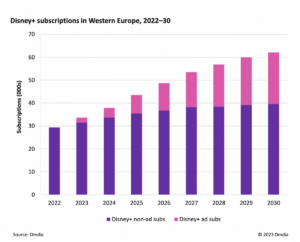
After more than 35 years of operation, TBI is closing its doors and our website will no longer be updated daily. Thank you for all of your support.
TBI Tech & Analysis: How Disney+’s move towards AVOD aims to reignite subs growth
Omdia’s Rob Moyser & Matthew Evenson explore the growth of Disney+’s ad-supported subscription tier and how it is expected to account for almost a quarter of total revenue for the Mouse House streamer by 2028.
Loki and Ahsoka streamer Disney+ expanded its ad-supported subscription across Europe on 1 November, 2023, with the tier launching in the UK, France, Germany, Switzerland, Italy, Spain, Norway, Sweden, and Denmark nearly a full year after successfully launching in the US. This move to become a hybrid AVOD service was driven by a need to boost its subscription base while also finding new ways to diversify its revenue streams, with the player also adding a premium tier to its subscription offer.
The move toward AVOD has been a great success for its competitor Netflix, helping the company to turn around its fortunes for both its subscriber base and revenue streams. In the case of Disney+, Omdia anticipates similar rates of growth with 32% of total subscriptions in Western Europe made up of ad subscription by 2028, totaling 18.4 million customers.
On the revenue front, this amounts to revenues of $1bn by 2028 and a 24% share of total revenue. Disney+ is also likely to increase its standard price in its European markets next year as well, continuing a plan it has already implemented in the US in August 2023, which increased its revenue take even further.
Despite its cheaper price, Netflix and Disney are keen to push subscribers toward ad tiers as they ultimately generate more revenue from lower-value customers while sustaining a comparatively lower cost for the consumer.
The extract above is from ‘2024 Trends to Watch: TV & Online Video in Europe’ written by Rob Moyser, senior analyst, TV & online video and Matthew Evenson, research analyst, media & entertainment, at research powerhouse Omdia. The full report is available to read in full here (with a subscription).




